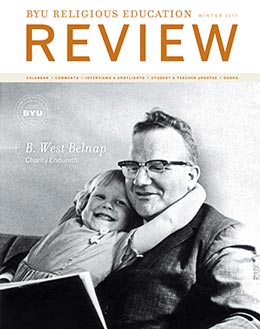A "Blessed Experience"
Students Honored to Work on Partridge Papers
Twenty-five years ago, master forger Mark Hofmann, who had secretly produced dozens of fake documents related to early American and Church history, claimed to have possession of several documents created by the controversial early Apostle William E. McLellin. When he failed to produce the McLellin collection and could not pay his debts, Hofmann tried to cover up his crimes by setting off homemade explosives. When Hofmann’s bombs rocked the Salt Lake City area, the event set off a chain of events that would eventually give a young Steven C. Harper an opportunity to study early Church history documents.
Soon after the Hofmann episode, Church archivists discovered many of McLellin’s papers within the Church’s own holdings. The Church later invited Jan Shipps, a renowned scholar of Mormonism, to prepare the important documents for publication by an academic press. She in turn collaborated with John W. Welch, editor in chief of BYU Studies, Steven Harper, then an undergraduate and an editorial assistant for BYU Studies, was assigned to help with the project. “The opportunity to be mentored by excellent scholars on a documentary edition of such significance became the most formative experience of my education,” Harper says.
Since that experience, Professor Harper says, “the question for me became, ‘How can I replicate my blessed experience for students?’” This thinking led him to propose a project in which he would mentor student researchers in editing the papers of Edward Partridge, one of the Church’s earliest converts and its first bishop.
“Partridge left a rich documentary legacy that is vital to understanding the early Mormon past,” says Dr. Harper. “But to spread that knowledge widely, his handwritten papers had to be carefully transcribed, painstakingly verified, and accurately introduced and annotated.” Harper knew that to complete the project, which was generously funded by BYU and supplemented by funds from Religious Education and from Harvey and Susan Easton Black, he would need a group of top-notch students. As he assembled his team, Dr. Harper says, “the students selected themselves.” Sherilyn Farnes, who wrote her master’s thesis at BYU on the papers of Lydia and Edward Partridge and their descendants, was the natural choice to be the team’s managing editor. Three standout undergraduates, Whitney Metcalfe, Brady Winslow, and Mitch Schaefer, rounded out the team.
“I enjoyed watching my students experience the sacred thrill of working with original holographs in the stunning new Church History Library,” Dr. Harper says. “They reverently examined papers on which Bishop Partridge had placed his pen. They pored over the consecration deeds he prepared and discovered evidence in his letters of what the Lord meant when he described Edward as a man ‘in whom there is no guile’ (D&C 41:11).”
The experience has had lasting effects on the student researchers. Brady Winslow says that the training he received “could have come through no other way other than participating in a project like this.” Sherilyn Farnes agrees: “Even after having written my thesis about Edward Partridge, I felt like I learned so much more about him as a person as I immersed myself in his documents.” Whitney Metcalfe says, “The decision to join this great team of editors was the best decision I made during my college career. Projects like the Partridge Papers will help us on our way to understanding the past.”
“The Edward Partridge Papers will be submitted to the Religious Studies Center for publication,” Dr. Harper says. “We offer it in response to the generous investments made in us and as evidence of the great possibilities of student mentoring opportunities. It will be a monument to the first bishop of the last dispensation, whose motto his fortunate document editors have adopted: ‘I feel willing to spend and be spent in the cause of my blessed Master.’”
